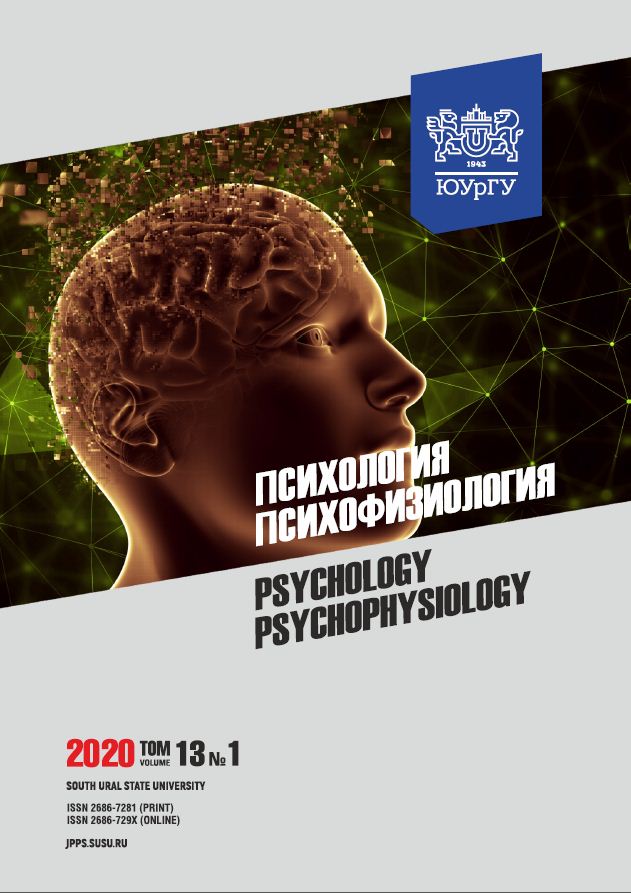PSYCHOPHYSIOLOGICAL ASPECTS OF ADAPTATION IN FOREIGN STUDENTS WITH WEAKENED HEALTH
Abstract
Background: About 40% of foreign students from 150 countries of the world study at the Peoples' Friendship University of Russia. Unusual environment, other sociocultural traditions, climatic and geographic factors, time-related changes make special demands on the adaptation
of foreign students. It is especially difficult for students with health status deviations. Aim: The article aims to assess the psychophysiological parameters of adaptation in foreign students with impaired health status. Materials and methods: The study was conducted on the basis of the Peoples' Friendship University of Russia. Male students aged from 18 to 19 years participated in the study. All students belong to a special medical group for health reasons and are divided into two groups: the control (Russian students, n = 28) and experimental (foreign students, n = 35) groups. To assess the psychophysiological features of adaptation, the indicators of response to light and sound stimuli were used, as well as the test of maximum oxygen consumption, the duration of individual minutes, and the orthostatic test conducted with the help of Sports psychophysiologist hardware and software complex (no. 2010617789). The obtained data were subjected to variational and statistical analysis using the Microsoft Excel 2010 and SPSS (version 19.0 for Windows) software. The survey was conducted with the written consent of the students. Results: Significant differences in simple sensorimotor response to light and sound stimuli were revealed in foreign students compared to Russian students (P ≤ 0.05). Also, more than half of the students from both groups had a low level of physical performance. However, males from the experimental group were characterized by lower values. The duration of the individual minute in foreign students with health status deviations is much shorter than in students from the control group. There were no significant differences in the data btained in the orthostatic test. Conclusion: In males of both groups, pathological processes are characterized by a decrease in the functional capacities. However, most psychophysiological parameters are worse in foreign students. This indicates a decrease in the adaptive capacity of students from the experimental group and indirectly indicates the imbalance in the psychophysiological status.
Downloads
References
2. Guminsky A.A., Leontieva N.N., Marinova K.V. Rukovodstvo k laboratornym zanyatiyam po obshchey i vozrastnoy fiziologii [Guide to laboratory classes in General and age physiology]. Moscow, Education, 1990. 239 p.
3. Ilyin E.P. Psikhomotornaya organizatsiya cheloveka [Psychomotor organization of man]. St. Petersburg, 2003. 384 p.
4. Kirsanov V.M., Shibkova D.Z. [Psychophysiological characteristics of the personality of students in the period of adaptation to study at the University]. Sibirskiy pedagogicheskiy zhurnal [Siberian pedagogical journal], 2012, no. 9, pp. 127–132. (in Russ.).
5. Koryagina Yu.V., Nopin S.V. [Hardware and software complex «Sports psychophysiologist» (APK «Sports psychophysiologist») no. 2010617789]. Programmy dlya EVM. Bazy dannykh. Topologii integralnykh mikroskhem [Computer program. Data base. Topology of integrated circuits]. 2011, no. 1, part 2, p. 308 (in Russ.).
6. Kuznetsov V.I., Vyalov S.S., Khodorovich A.M. [Acceleration of adaptation processes of foreign students with chronic diseases: prospects and opportunities (research on the program «Health»)]. Vestnik RUDN. Seriya Meditsina [Bulletin of the Russian Friendship University, Medicine series], 2010, no. 2, pp. 51–57. (in Russ.).
7. Makarova G.A. Sportivnaya meditsina [Sports medicine]. Moscow, Sovetsky Sport, 2003. 480 p.
8. Malyarenko T.N., Shutova S.V. [Individual typological features of psychophysiological indicators in young men 19-20 years]. Vestnik Tambovskogo universiteta. Seriya Estestvennye i tekhnicheskie nauki [Bulletin of the Tambov University. A series of Natural and technical Sciences], 2000, vol. 5, is. 1, pp. 60–64. (in Russ.).
9. Milashechkin V.S. [Duration of individual minute at students from China of the first course referred to special medical group]. Ekologo-fiziologicheskie problemy adaptatsii, materialy XVIII Vserossiyskogo simpoziuma s mezhdunarodnym uchastiem. Rossiyskiy universitet druzhby narodov [Ecological and physiological problems of adaptation, materials of the XVIII all-Russian Symposium with international participation. Peoples Friendship University of Russia]. Moscow, 2019. pp. 145–147. (in Russ.).
10. Redko A.V., Bacherikov E.L., Sharov B.B., Kamskova Yu.G. [Changing the processes of sensorimotor integration of the students in the course of the academic year]. Bulletin of the South Ural State University. Ser. Education, Healthcare Service, Physical Education, 2011, no 26 (243), pp. 26–28. (in Russ.)
11. Timofeeva O.V., Milashechkina E.A., Malchenko A.D., Kunitsyna E.A. [Influence of gymnastics dance orientation on the psycho-emotional state of foreign first-year students]. Teoriya i metodika fizicheskoy kultury [Theory and methods of physical culture], 2018, no. 6, pp. 47–48. (in Russ.).
12. Deore D.N., Surwase S.P., Masroor S., Khan S.T., Kathore V. A cross sectional study on the relationship between the body mass index (bmi) and the audiovisual reaction time (ART). J. Clin. Diagn. Res. 2012, vol. 6 (9), pp. 1466–1468.
13. Padilla-Medina J.A., Prado-Olivarez J., Amador-Licona N. et al. Study on simple reaction and choice times in patients with type I diabetes. Comput. Biol. Med. 2013, vol. 43 (4), pp. 368–376.
14. Roth N., Sack G. Relations between slow (4 CPS) EEG activity, sensorimotor speed and psychopathology. Int. J. Psychophysiol. 1990, vol. 9, no. 2, pp. 121–127.
15. Takarae Y., Luna B., Minshew N. Patterns of visual sensory and sensorimotor abnormalities in autism vary in relation to history of early language delay. J. Int. Neuropsychol. Soc. 2008, vol. 14 (6), pp. 980–989.
References on translit
Copyright (c) 2020 Psychology. Psychophysiology

This work is licensed under a Creative Commons Attribution-NonCommercial-NoDerivatives 4.0 International License.



